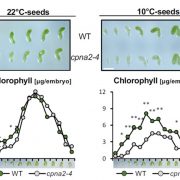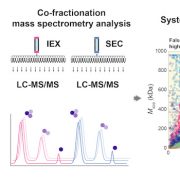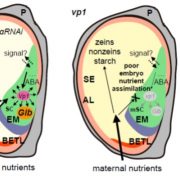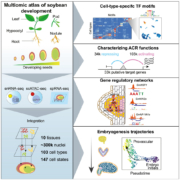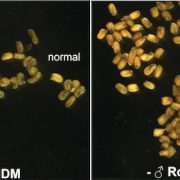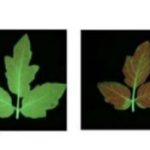Lipid Synthesis and Beyond: SAD Fatty Acid Desaturases Contribute to Seed Development
Fatty acid (FA) desaturases have long been recognized as key enzymes in synthesizing lipids containing unsaturated FAs, which constitute the majority of seed oil. As a major class of FA desaturases, stearoyl-acyl carrier protein desaturases (SADs) catalyze the first desaturation step, producing the monounsaturated FA oleic acid, which can be further desaturated to polyunsaturated FA. Thus, SADs play an important role in determining seed oil content and composition. However, a comprehensive characterization of SAD function in seed development is lacking due to the potential redundancy of multiple SAD isoforms. In this issue of The Plant Cell, Sami Kazaz and colleagues (Kazaz et al., 2020) thoroughly characterized a series of single and multiple sad mutants to untangle the complicated functional redundancy of these SADs during seed development.
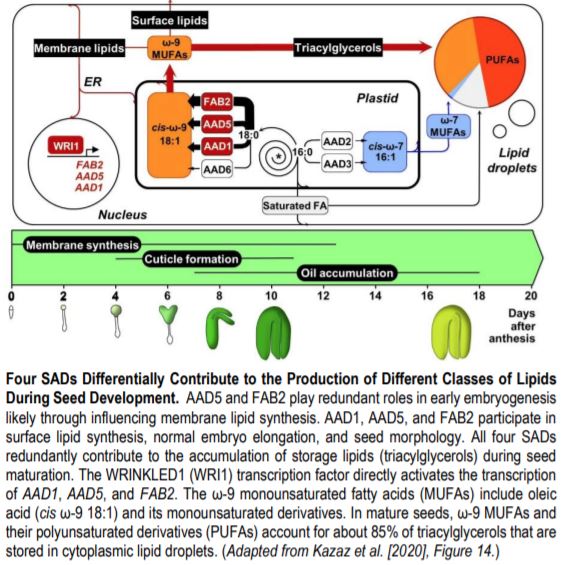 To identify the SADs responsible for making oleic acid in seeds, the authors examined the expression patterns of seven Arabidopsis thaliana genes coding for SAD candidates, and found four genes (AAD1, AAD5, AAD6, and FAB2) whose expression profiles correlates with the accumulation of oleic acid and its derivatives during seed development. Within these four candidates, FAB2 is a well characterized SAD. To test whether the other three candidates contribute to oleic acid production, the authors expressed each of them in leaves of the fab2 mutant, which was reported to have increased levels of stearic acid, the precursor of oleic acid, in leaves (Lightner et al., 1994). Subsequent analysis of the transgenic lines showed that these isoforms partially reverted the FA composition phenotype in fab2 mutant leaves, suggesting that AAD1, AAD5, and AAD6 (like FAB2) are SADs participating in oleic acid synthesis in planta.
To identify the SADs responsible for making oleic acid in seeds, the authors examined the expression patterns of seven Arabidopsis thaliana genes coding for SAD candidates, and found four genes (AAD1, AAD5, AAD6, and FAB2) whose expression profiles correlates with the accumulation of oleic acid and its derivatives during seed development. Within these four candidates, FAB2 is a well characterized SAD. To test whether the other three candidates contribute to oleic acid production, the authors expressed each of them in leaves of the fab2 mutant, which was reported to have increased levels of stearic acid, the precursor of oleic acid, in leaves (Lightner et al., 1994). Subsequent analysis of the transgenic lines showed that these isoforms partially reverted the FA composition phenotype in fab2 mutant leaves, suggesting that AAD1, AAD5, and AAD6 (like FAB2) are SADs participating in oleic acid synthesis in planta.
Given the putative functional redundancy between these four SADs, creating multiple sad mutants appeared to be the necessary next step to further explore their functional roles during seed development. However, during the creation of multiple sad mutants, the authors discovered that it was not possible to generate aad5 fab2 double homozygous mutants. Dissecting this with microscopy imaging of mutant embryos showed that the double loss-of-function aad5 fab2 mutant arrested embryo development near the onset of embryogenesis. This indicated that AAD5 and FAB2 play redundant roles necessary for early embryogenesis likely due to their requirement for membrane lipid synthesis during cell division and expansion.
To overcome the limitation caused by the embryo lethality of the aad5 fab2 mutant, the authors created leaky double mutants with a knockout mutation in one gene and a leaky mutation in the other, which was subsequently used to generate triple and quadruple mutants. Lipid analysis of these mutants showed additive effects on storage lipid (i.e., triacylglycerol) accumulation in seeds, demonstrating that these four SADs redundantly contribute to storage lipid deposition in seeds.
Further examination of seed morphology revealed a twisted seed phenotype in aad1 fab2 and aad5 fab2 mutants, which later was determined to be a consequence of improper embryo-endosperm separation during embryo elongation. These findings prompted the authors to ask how the mutations in SADs affect embryo elongation. A previous study demonstrated that the cuticle layer at the embryo surface is an essential barrier for embryo-endosperm separation (Moussu et al., 2017). The main component in cuticle is cutin, a type of surface lipid composed of FA derivatives. Therefore, the authors analyzed cutin in the mutants with twisted seeds and observed a significant decrease in certain oleic acid-derived monomers and a concomitant increase in saturated monomers, suggesting that AAD1, AAD5, and FAB2 redundantly participate in surface lipid synthesis and consequently influence embryo elongation.
In summary, this paper describes the functional diversity and redundancy of four SADs in synthesizing membrane lipids, surface lipids, and storage lipids at different stages of seed development (see figure). Since storage lipids represent the major form of lipids in mature seeds, other lipid classes are often overlooked when studying lipid metabolism during seed development. The findings in this paper highlight the importance of membrane lipids and surface lipids for seed development and the roles of SADs in these processes.
Yingqi Cai
Biology Department
Brookhaven National Laboratory
Upton, New York
ORCID: 0000-0002-0357-5809
REFERENCES
Lightner, J., Wu, J., and Browse, J. (1994). A mutant of Arabidopsis with increased levels of stearic acid. Plant Physiol. 106: 1443-1451.
Moussu, S., Doll, N.M., Chamot, S., Brocard, L., Creff, A., Fourquin, C., Widiez, T., Nimchuk, Z.L., and Ingram, G. (2017). ZHOUPI and KERBEROS mediate embryo/endosperm separation by promoting the formation of an extracuticular sheath at the embryo surface. Plant Cell 29: 1642-1656.


